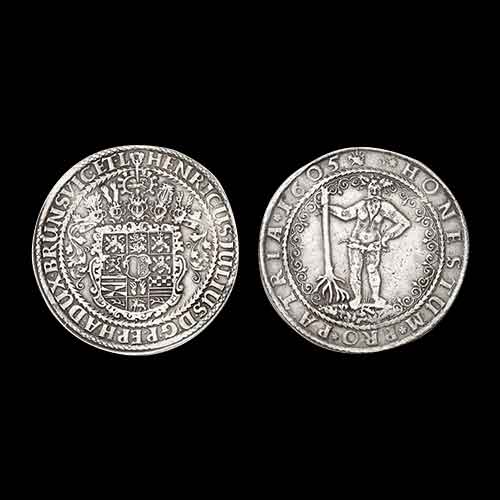Silver Wildman Taler
2022-09-14 Wed
One of the most famous Germanic coins is the “Wildman taler.” Wildman taler was influenced by pagan tradition in the Harz Mountain region of Germany, where the wildman appears in folklore and other forms of art but not many coins feature this pagan mythological creature.The Harz was a major silver-producing region and the imagery is a reference to the mining city Wildemann and the legend of its foundation. As the story goes, in 1529, miners who were sent out to find new ore deposits discovered a wild man who lived with a wild woman. They captured him, but he died as a result of his injuries. Large silver ore deposits were reportedly discovered where he had lived.
The Wildman, according to Germanic Coinages was the medieval European equivalent of the American Bigfoot or Sasquatch. Typical Wildman coins show a gigantic beast, usually hairy and muscled, wearing a loincloth of leaves, with only its hands and feet free of fur. The creature is often seen grasping the trunk of a tree, sometimes with a city or forest in the background.
Image Courtesy: coinworld.com
Latest News
-
Malwa Sultan Mahmud Shah Silver Coins
2025-09-11 ThuMalwa Sultan Mahmud Shah minted silver coins in round and square flans. <br><br> For round coins,...
-
Malwa Sultan Mahmud Shah Billon coin
2025-08-26 TueMalwa Sultan Mahmud Shah's billon coins followed three weight standards: 100 rati, 96 rati, and 80 r...
-
Fascinating Archaeological Facts on Postage Stamps - 91
2025-08-23 SatRhinoceros is one of the oldest land mammal species existing in India. There are five species of rhi...
-
Fascinating Archaeological Facts on Postage Stamps - 90
2025-08-23 SatUthiramerur, a Village in Kanchipuram, Tamil Nadu, is notable for its Temple inscriptions that descr...
-
Fascinating Archaeological Facts on Postage Stamps - 89
2025-08-21 ThuThe term “millet” is derived from the Latin word “milum,” which translates to grain. millets...

